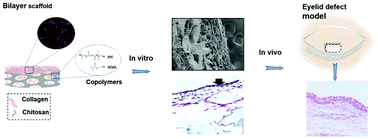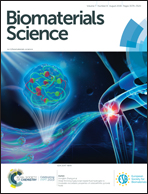A biomimetic tarso-conjunctival biphasic scaffold for eyelid reconstruction in vivo†
Abstract
Conventional 3D porous scaffolds used as tarsal plate substitute may cause corneal irritation and conjunctival mucoid discharge, and even lead to blindness and cicatricial blepharon deformities. In this study, collagen/chitosan (Col/CS) sponges with thickness of 240 μm, 466 μm, and 724 μm were composited onto poly(propylene fumarate)-co-2-hydroxyethyl methacrylate (PPF–HEMA) polymer networks to obtain the corresponding biphasic scaffolds, which simulate the natural anatomy of posterior lamella of eyelid. These three scaffolds exhibited a porous structure with porosity of ∼90%, simulated elastic modulus, appropriate degradation rate and good biocompatibility. Composited with Col/CS sponge of difference thickness, the scaffolds induced different cellular behaviors such as proliferation, distribution and stratification, by regulating the mechanical properties cells sensed as effective modulus. In a rabbit tarso-conjunctival defect model, the grafted biphasic scaffolds promoted re-epithelization with functional regenerated conjunctiva. Hence, the biphasic composite scaffolds may be a promising substitute for tarso-conjunctival repair.



 Please wait while we load your content...
Please wait while we load your content...